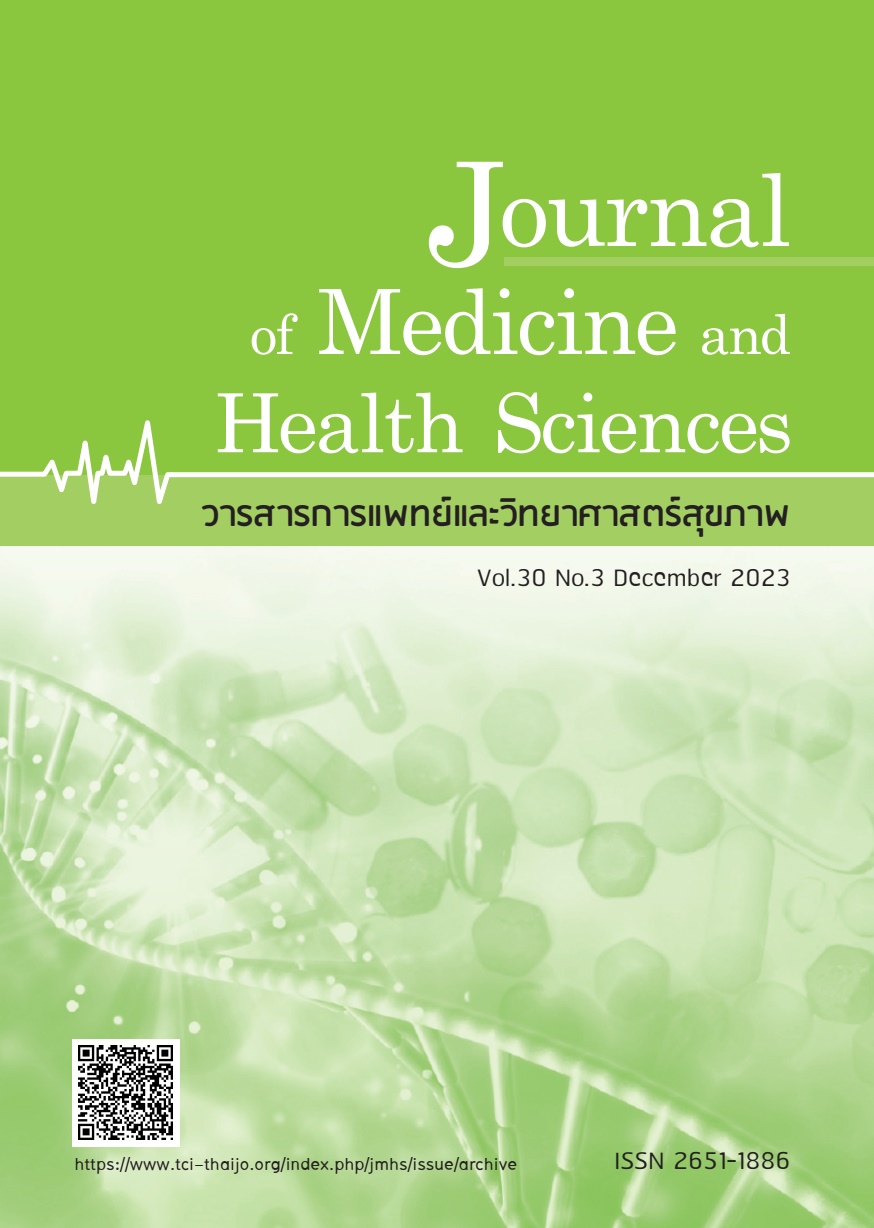A comparative outcomes of Nifedipine and Terbutaline in inhibiting preterm labor at Samutsakhon Hospital
Keywords:
Nifedipine, Terbutaline,, Inhibiting preterm labor, preterm laborAbstract
Preterm delivery stands as the main leading cause of perinatal morbidity and mortality. Consequently, tocolytic therapy for delaying preterm delivery holds significant importance. Commonly used tocolytic agents in Thailand include Nifedipine and Terbutaline, each with varied outcomes concerning pregnancy prolongation and effects on infants. This retrospective study aims to compare maternal outcomes and neonatal effects between Nifedipine and Terbutaline in inhibiting preterm labor at Samutsakhon Hospital. Samples comprised pregnant women with preterm labor meeting inclusion criteria, with 58 patients in the oral Nifedipine group and 124 patients in the intravenous Terbutaline group. Data were collected from medical records between January 1, 2021, and December 31, 2022, and statistical analysis employed Chi-square test, Independent t-test, and Multiple logistic regression. Results revealed no statistical differences in maternal age, body mass index, number of pregnancies, parity, abortion and preterm labor history, gestational age, antenatal care, cervical dilatation, and effacement in both groups. In terms of maternal outcomes, significant differences between Nifedipine and Terbutaline included the duration of inhibition (hours) (55.54±17.07 vs. 42.76±16.01, p<0.001) and the percentage of prolonged gestation at 7 days (63.79% vs. 34.68%; aOR 3.01, 95%CI 1.40-6.01, p<0.001). Regarding neonatal outcomes, differences were noted in Apgar score at 1 minute (7.78±1.12 vs. 6.73±2.21, p=0.001), birth weight (grams) (2,257.67±686.77 vs. 1,972.26±610.00, p=0.008), percentage of transfer to NICU (8.62% vs. 24.19%; aOR 0.34, 95%CI 0.12-0.80, p=0.040), and respiratory distress syndrome (22.41% vs. 45.97%; aOR 0.36, 95%CI 0.17-0.77, p=0.008). In conclusion, the use of Nifedipine in inhibiting preterm labor demonstrated more effective outcomes than Terbutaline in terms of prolonging gestation and neonatal effects, along with ease of drug administration.
References
ACOG. Management of preterm labor. The American College of Obstetricians and Gynecologists practice bulletin No171. Obstet Gynecol 2016;128:e155-64.
Cunningham F, Leveno KI, Bloom SI, et al. Williams Obstetrics 24th edition. New York: The McGraw-Hill companies; 2014.
Alamneh TS, Teshale AB, Worku MG. Preterm birth and its associated factors among reproductive aged women in sub-Saharan Africa: evidence from the recent demographic and health surveys of sub-Sharan African countries. BMC Pregnancy Childbirth 2021;21:770.
Kenny LC, Lavender T, McNamee R, et al. Advanced maternal age and adverse pregnancy outcome: evidence from a large contemporary cohort. PLoS One 2013;8:e56583.
Chang YK, Tseng YT, Chen KT. The epidemiologic characteristics and associated risk factors of preterm birth from 2004 to 2013 in Taiwan. BMC Pregnancy Childbirth 2020;20:201.
Tannirundon Y. Prevention of spontaneous preterm birth. In Tanpairoj P, & Chaiyasit N. (editors). OB and GYN improve applied operations. Bangkok: Concept & Medicus; 2012.
Leal M, Esteves-Pereira AP, NakamuraPereira M, et al. Prevalence and risk factors related to preterm birth in Brazil. Reprod Health 2016;13:127-65.
Hanarsa W. Prevalence and Risk Factors of Preterm Birth in Bungkan Hospital. UDHHOSMJ 2022;30:35-44. [in Thai]
Alijahan R, Hazrati S, Mirzarahimi M, et al. Prevalence and risk factors associated with preterm birth in Ardabil, Iran. Iran J Reprod Med 2014;12:46-56.
Phupong W, Tannirundorn Y. Preterm Labor. In Bunyawechchewin, S. & Tannirandon Y. (editors). Medical practice in obstetrics and gynecology, Bangkok, Chulalongkorn University printing press; 2015.
WHO. Preterm birth [Internet]. Retrieved March 2, 2023, Available from: http://www.who.int/newroom/factsheet/detail/preterm-birth.
Royal College of Obstetricians and Gynecologists of Thailand. The management of preterm labor and preterm premature rupture of membranes. [Internet]. Retrieved February 12, 2023. Available from: http://www.rtcog.or.th/home/cpg/1380/.
Thongsong, T. Prevention of premature birth. In Rueangchainikhom W, Chanratchakul B, Phromsonthi P, Chaiyasit N, Ruchiwetpongsakorn J & Kosolchuenwichit J. Contemporary empirical practice in maternal and fetal medicine. Bangkok: Union Creation; 2013.
Laohapojanart N, Suchada S, Teera W, et al. Safety and efficacy of oral nifedipine versus terbutaline injection in preterm labor. J Med Assoc Thai 2007;90:2461-9.
Devgan N, Barsaul M, Sindhwani R, et al. A Comparative Study of Nifedipine and Terbutaline as Tocolytic Agents in the Management of Preterm Labour. RJPPD 2013;5:232-6. [in Thai]
Dias TZ, Fava ML, Passini JR, et al. Tocolysis among Women with Preterm Birth: Associated Factors and Outcomes from a Multicenter Study in Brazil. Rev Bras Ginecol Obstet 2018;40:171-9.
Padovani TR, Guyatt G, Lopes LC. Nifedipine versus terbutaline, tocolytic effectiveness and maternal and neonatal adverse effects: a randomized, controlled pilot trial. Basic Clin Pharmacol Toxicol 2015;116:244-50.
Medical records database system, Samutsakhon Hospital. [Intranet]. Retrieved February 12, 2023. Available from: http://smkh.moph.go.th/skh/.
HDC, Ministry of Public Health. Standard report group. Retrieved February 12, 2023. Available from: http://hdcservice.moph.go.th/hdc/reports/report.php?cat_id=1ed90bc32310b503b7ca9b32af425ae5&id=ce4f9fcd9cd41b6cb2f79b2440a6f4cc.
Mawaldi L, Duminy P, Tamim H. Terbutaline versus nifedipine for prolongation of pregnancy in patients with preterm labor. Int J Gynaecol Obstet 2008;100:65-8.
Morris I, Adappa R. Minimizing the Risk of Respiratory Distress Syndrome. Paediatr Child Health 2012;22:513-7.
Varvarigou AA, Thomas I, Rodi M, et al. Respiratory Distress Syndrome (RDS) in premature infants is underscored by the magnitude of the cytokine polarization. Cytokine 2015;58:355-60.
Saboute M, Kashaki M, Bordbar A, et al. The Incidence of Respiratory Distress Syndrome among preterm infants admitted to neonatal intensive care unit: A retrospective study. Open J Pediatr 2015;5:285-9.
Gebreheat G, Tadesse B, Teame H. Predictors of respiratory distress syndrome, sepsis and mortality among preterm neonates admitted to neonatal intensive care unit in northern Ethiopia. J Pediatr Nurs 2022;63:e113-e120.
Downloads
Published
How to Cite
Issue
Section
License

This work is licensed under a Creative Commons Attribution-NonCommercial-NoDerivatives 4.0 International License.



